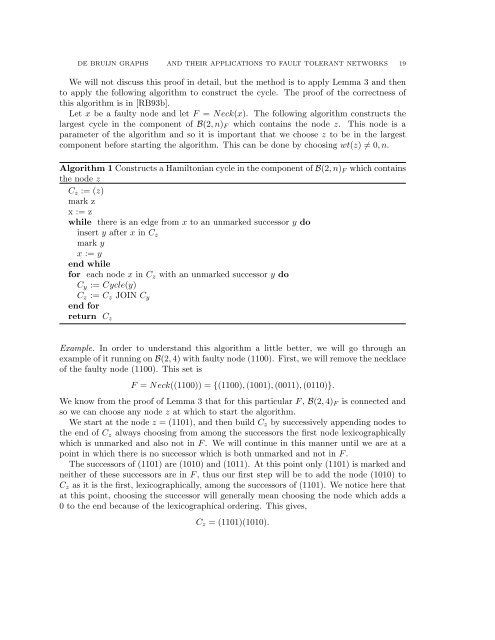De Bruijn Graphs and their Applications to Fault Tolerant Networks
De Bruijn Graphs and their Applications to Fault Tolerant Networks
De Bruijn Graphs and their Applications to Fault Tolerant Networks
You also want an ePaper? Increase the reach of your titles
YUMPU automatically turns print PDFs into web optimized ePapers that Google loves.
DE BRUIJN GRAPHS AND THEIR APPLICATIONS TO FAULT TOLERANT NETWORKS 19We will not discuss this proof in detail, but the method is <strong>to</strong> apply Lemma 3 <strong>and</strong> then<strong>to</strong> apply the following algorithm <strong>to</strong> construct the cycle. The proof of the correctness ofthis algorithm is in [RB93b].Let x be a faulty node <strong>and</strong> let F = Neck(x). The following algorithm constructs thelargest cycle in the component of B(2, n) F which contains the node z. This node is aparameter of the algorithm <strong>and</strong> so it is important that we choose z <strong>to</strong> be in the largestcomponent before starting the algorithm. This can be done by choosing wt(z) ≠ 0, n.Algorithm 1 Constructs a Hamil<strong>to</strong>nian cycle in the component of B(2, n) F which containsthe node zC z := (z)mark zx := zwhile there is an edge from x <strong>to</strong> an unmarked successor y doinsert y after x in C zmark yx := yend whilefor each node x in C z with an unmarked successor y doC y := Cycle(y)C z := C z JOIN C yend forreturn C zExample. In order <strong>to</strong> underst<strong>and</strong> this algorithm a little better, we will go through anexample of it running on B(2, 4) with faulty node (1100). First, we will remove the necklaceof the faulty node (1100). This set isF = Neck((1100)) = {(1100), (1001), (0011), (0110)}.We know from the proof of Lemma 3 that for this particular F , B(2, 4) F is connected <strong>and</strong>so we can choose any node z at which <strong>to</strong> start the algorithm.We start at the node z = (1101), <strong>and</strong> then build C z by successively appending nodes <strong>to</strong>the end of C z always choosing from among the successors the first node lexicographicallywhich is unmarked <strong>and</strong> also not in F . We will continue in this manner until we are at apoint in which there is no successor which is both unmarked <strong>and</strong> not in F .The successors of (1101) are (1010) <strong>and</strong> (1011). At this point only (1101) is marked <strong>and</strong>neither of these successors are in F , thus our first step will be <strong>to</strong> add the node (1010) <strong>to</strong>C z as it is the first, lexicographically, among the successors of (1101). We notice here thatat this point, choosing the successor will generally mean choosing the node which adds a0 <strong>to</strong> the end because of the lexicographical ordering. This gives,C z = (1101)(1010).
















